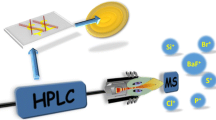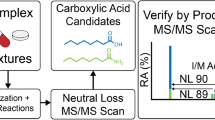Abstract
Elemental mass spectrometry offers quantitation and isotopic analysis without the need for compound-specific standards. We have recently introduced plasma assisted reaction chemical ionization (PARCI) as an efficient elemental ionization method for halogens. Here, we report a new ionization chemistry in PARCI for facile quantitation of elemental carbon in gas chromatography eluates. We demonstrate that in-plasma reactions of organic compounds followed by afterglow ionization lead to formation of polyatomic anions (CN−, OCN−, and CO3 −), among which CN− offers the best analytical sensitivity with a detection limit of ~25 pg (21 pg/s) carbon on column. Using a mixture of pesticides with wide variations in structures and heteroatom content, we demonstrate that CN− ion response is quantitatively correlated with the carbon concentration over two orders of magnitude (r 2 = 0.985). We show that the novel GC-PARCI-MS method provides recoveries within 80–120% using a single standard for all analytes, highlighting the strength of elemental quantitation. Further, the ability of GC-PARCI-MS to identify 13C-tagged molecules without a priori knowledge of chemical formulas of analytes is demonstrated.

ᅟ







Similar content being viewed by others
References
Richardson SD, Kimura SY. Water analysis: emerging contaminants and current issues. Anal Chem. 2016;88:546–82.
Bletsou AA, Jeon J, Hollender J, Archontaki E, Thomaidis NS. Targeted and non-targeted liquid chromatography-mass spectrometric workflows for identification of transformation products of emerging pollutants in the aquatic environment. Trends Anal Chem. 2015;66:32–44.
Chokkathukalam A, Kim DH, Barrett MP, Breitling R, Creek DJ. Stable isotope-labeling studies in metabolomics: new insights into structure and dynamics of metabolic networks. Bioanalysis. 2014;6:511–24.
Holm T. Aspects of the mechanism of the flame ionization detector. J Chromatogr A. 1999;842:221–7.
Van Stee LLR, Brinkman UAT. Developments in the application of gas chromatography with atomic emission (plus mass spectrometric) detection. J Chromatogr A. 2008;1186:109–22.
Han BJ, Jiang XM, Hou XD, Zheng CB. Dielectric barrier discharge carbon atomic emission spectrometer: universal GC detector for volatile carbon-containing compounds. Anal Chem. 2014;86:936–42.
Brandt S, Schütz A, Klute F, Kratzer J, Franzke J. Dielectric barrier discharges applied for optical spectrometry. Spectrochim Acta B. 2016;123:6–32.
Li CH, Long Z, Jiang XM, Wu P, Hou XD. Atomic spectrometric detectors for gas chromatography. Trends Anal Chem. 2016;77:139–55.
Guchardi R, Hauser PC. Determination of organic compounds by gas chromatography using a new capacitively coupled microplasma detector. Analyst. 2004;129:347–51.
Diaz SC, Encinar JR, Sanz-Medel A, Alonso JIG. A quantitative universal detection system for organic compounds in gas chromatography with isotopically enriched (CO2)-C-13. Angew Chem Int Ed. 2009;48:2561–4.
Diaz SC, Encinar JR, Sanz-Medel A, Alonso JIG. Gas chromatography-combustion-mass spectrometry with postcolumn isotope dilution for compound-independent quantification: its potential to assess HS-SPME procedures. Anal Chem. 2010;82:6862–9.
Diaz SC, Encinar JR, Sanz-Medel A, Alonso JIG. Towards compound-independent calibration for organic compounds using online isotope dilution mass spectrometry. Anal Bioanal Chem. 2012;402:91–7.
Song HC, Kusmierz J, Abramson F, Mclean M. Implementation of the chemical-reaction interface mass-spectrometry technique on a Hewlett-Packard mass-selective detector. J Am Soc Mass Spectrom. 1994;5:765–71.
McLean M, Vestal ML, Teffera Y, Abramson FP. Element- and isotope-specific detection for high-performance liquid chromatography using chemical reaction interface mass spectrometry. J Chromatogr A. 1996;732:189–99.
Sobrado LA, Fernandez MR, Diaz SC, Encinar JR, Alonso JIG. Modification of a commercial gas chromatography isotope ratio mass spectrometer for on-line carbon isotope dilution: evaluation of its analytical characteristics for the quantification of organic compounds. J Chromatogr A. 2015;1419:99–108.
Sobrado LA, Freije-Carrelo L, Moldovan M, Encinar JR, Alonso JIG. Comparison of gas chromatography-combustion-mass spectrometry and gas chromatography-flame ionization detector for the determination of fatty acid methyl esters in biodiesel without specific standards. J Chromatogr A. 2016;1457:134–43.
Lin NH, Wang HP, Kahen K, Badiei H, Jorabchi K. Gas chromatography plasma-assisted reaction chemical ionization mass spectrometry for quantitative detection of bromine in organic compounds. Anal Chem. 2014;86:7954–61.
Wang HP, Lin NH, Kahen K, Badiei H, Jorabchi K. Plasma-assisted reaction chemical ionization for elemental mass spectrometry of organohalogens. J Am Soc Mass Spectrom. 2014;25:692–5.
Wang HP, Minardi CS, Badiei H, Kahen K, Jorabchi K. High-sensitivity elemental ionization for quantitative detection of halogenated compounds. Analyst. 2015;140:8177–85.
Wenig P, Odermatt J. OpenChrom: a cross-platform open source software for the mass spectrometric analysis of chromatographic data. Bmc Bioinformatics. 2010;11:405.
Gonzalez AM, Uden PC. Optimization and evaluation of atomic emission gas chromatographic detection for nitrogen using the 388 nm molecular emission spectral band. J Chromatogr A. 2000;898:201–10.
Li CH, Jiang X, Hou XD. Dielectric barrier discharge molecular emission spectrometer as gas chromatographic detector for amines. Microchem J. 2015;119:108–13.
Yuan X, Ding XL, Zhao ZJ, Zhan XF, Duan YX. Performance evaluation of a newly designed DC microplasma for direct organic compound detection through molecular emission spectrometry. J Anal At Spectrom. 2012;27:2094–101.
Dong M, Chan GC-Y, Mao X, Gonzalez JJ, Lu J, Russo RE. Elucidation of C 2 and CN formation mechanisms in laser-induced plasmas through correlation analysis of carbon isotopic ratio. Spectrochim Acta Part B. 2014;100:62–9.
Braman RS, Dynako A. Direct current discharge spectral emission-type detector. Anal Chem. 1968;40:95–106.
Unkefer CJ, Martinez RA. The use of stable isotope labelling for the analytical chemistry of drugs. Drug Test Anal. 2012;4:303–7.
Fenner K, Canonica S, Wackett LP, Elsner M. Evaluating pesticide degradation in the environment: blind spots and emerging opportunities. Science. 2013;341:752–8.
Acknowledgements
This material is based upon work supported by the National Science Foundation (NSF) under CHE-1507304. We thank PerkinElmer Inc. for the loan of the mass spectrometers and for financial support. We are grateful to Dr. Hamid Badiei of PerkinElmer for discussions during the course of this work.
Author information
Authors and Affiliations
Corresponding author
Ethics declarations
Conflict of interest
The authors declare that they have no conflict of interest.
Electronic supplementary material
ESM 1
(PDF 315 kb)
Rights and permissions
About this article
Cite this article
Haferl, P.J., Zheng, K., Wang, H. et al. Elemental quantitation of carbon via production of polyatomic anions in gas chromatography-plasma assisted reaction chemical ionization mass spectrometry. Anal Bioanal Chem 409, 3843–3851 (2017). https://doi.org/10.1007/s00216-017-0328-4
Received:
Revised:
Accepted:
Published:
Issue Date:
DOI: https://doi.org/10.1007/s00216-017-0328-4




